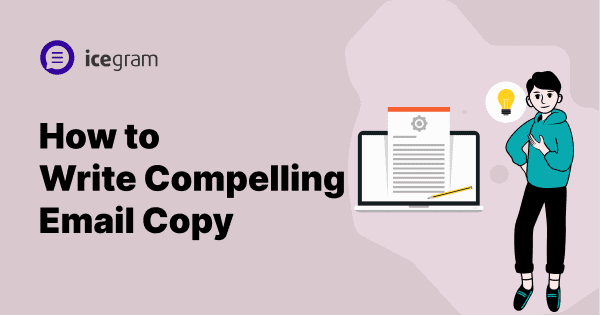In the fast-paced world of digital marketing, email remains a powerful tool for reaching your audience and driving business growth. But with countless emails flooding inboxes daily, how do you make yours stand out? The answer lies in mastering the art of email copywriting.
Crafting compelling email copy is crucial to your success. It’s the key to boosting open rates, increasing click-throughs, and ultimately driving more conversions. In this blog post, we’ll share five proven email copywriting tips to help you write emails that not only get noticed but also inspire action.
Why email marketing matters in 2024
Before we dive into the tips, let’s quickly recap why email marketing is still a game-changer:
- Global Reach: Email boasts a vast reach, connecting you with potential customers worldwide.
- Personalization: Tailor messages for higher engagement based on individual preferences.
- Cost-Effective: It’s significantly more affordable than traditional advertising.
- High Visibility: People check their emails regularly, increasing the chances of your message being seen.
- Targeted Segmentation: Reach the right people with the right message using segmentation.
Email offers a unique blend of reach, personalization, and affordability that few other channels can match. Now, let’s explore how to make the most of it.
5 Tips For Writing Informative And Compelling Email Copy
A good email is one that engages and informs the recipient while also inspiring them to take action. But what exactly makes an email stand out from the sea of messages flooding our inboxes every day?
Crafting informative and compelling email copy is the key to capturing your audience’s attention and driving engagement. Here are a few expert tips to help you create emails that deliver valuable information while persuading readers to take action:
Keep it short and sweet
In a fast-paced world, brevity is crucial. Keep your email copy concise, delivering your message in a clear and succinct manner. Cut out unnecessary details and focus on what’s most important.
Consider using bullet points or subheadings to make your content scannable, allowing readers to grasp the main points quickly. By keeping it short and sweet, you’ll hold your reader’s attention and increase the chances of them absorbing your message.
Example: “Ready to boost your email open rates? Download our free checklist now!”
Get to the point
When it comes to email, there’s no time for beating around the bush. Capture your reader’s attention from the start by getting straight to the point. Avoid lengthy introductions or unnecessary preamble.
Instead, clearly communicate the purpose of your email in the opening lines. You’ll make a strong impression and increase engagement by immediately addressing the reader’s needs or offering a solution to their problem.
Example: Instead of “We are excited to announce our new product…”, try “Check out our new and revolutionize the way you [benefit]!”
Write for your audience and be persuasive
Understanding your target audience is vital for crafting effective email copy. Tailor your language and tone to resonate with your readers. Consider their needs, preferences, and pain points. By personalizing your emails, you’ll create a sense of connection and relevance.
Additionally, employ persuasive language and techniques to encourage action. Highlight the benefits, use social proof, and create a sense of urgency to persuade readers to click, buy, or engage with your desired call-to-action.
Example: “Hi [Name], We’ve got something special just for you!”
Use attention-grabbing email subject lines
Subject lines play a crucial role in determining whether your emails get opened or end up in the dreaded “Trash” folder. Craft email subject lines that grab attention, pique curiosity, or convey value.
Experiment with different techniques such as personalization, asking questions, or using action-oriented language.
A/B testing can help you identify the subject lines that yield the highest email open rates. By nailing your email subject lines, you’ll increase the chances of your emails being read and acted upon.
Example: “Hi [Name], We’ve got something special just for you!”
Proper formatting and design
Visual appeal plays a significant role in email engagement. Ensure your emails are visually appealing and well-formatted. Use white space effectively to enhance readability and avoid overwhelming your readers.
Optimize your emails for mobile devices since a large percentage of people access emails on their smartphones. Incorporate relevant visuals, such as images or videos, strategically to enhance your message and make it more memorable.
Conclusion
Writing informative and compelling email copy is a skill that can greatly impact your marketing efforts. By following these five tips, you’ll be able to create emails that deliver valuable information while captivating your audience.
Keep your emails concise, get to the point quickly, write for your audience using persuasive language, craft attention-grabbing email subject lines, and pay attention to formatting and design. Implement these strategies and watch as your email engagement and conversion rates soar.
Start creating impactful email copy today and reap the rewards of effective communication with your audience.
FAQs
- Q: How long should my email subject lines be?
A: Aim for 50 characters or less to ensure your entire subject line displays correctly on most devices. - Q: How can I personalize my emails beyond just using the recipient’s name?
A: You can personalize content based on their past purchases, website interactions, or preferences indicated in a survey. - Q: What’s the difference between an informative and a compelling email?
A: An informative email primarily delivers valuable information or updates. A compelling email goes further, using persuasive language and emotional triggers to encourage the reader to take a specific action. Both are important for successful email marketing. - Q: How often should I send emails to my subscribers?
A: The ideal frequency depends on your audience and content. It’s best to experiment and find a balance that keeps your subscribers engaged without overwhelming them. Start with a weekly or bi-weekly cadence and adjust based on your open and click-through rates.
Additional resources:
- Writing Engaging Emails: Lessons From The Office’s Wittiest Workers
- Buffalo Bills’ Secrets: Transform Your Email Campaigns into a Winning Drive


